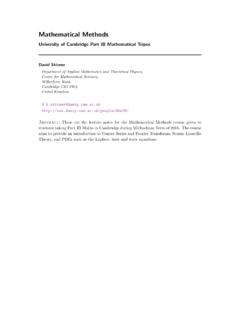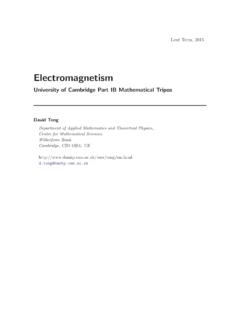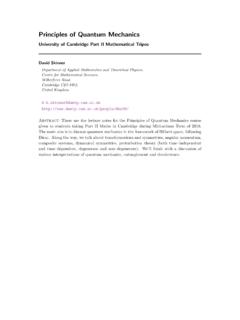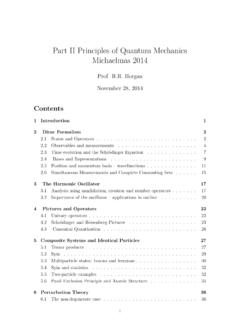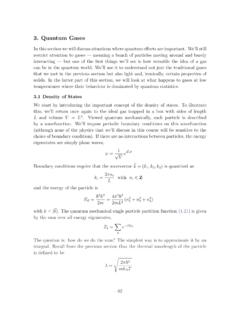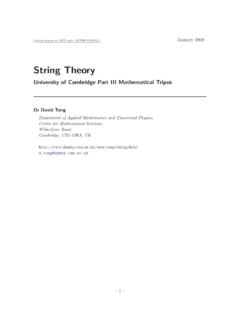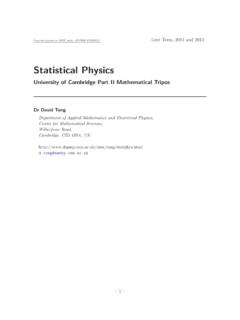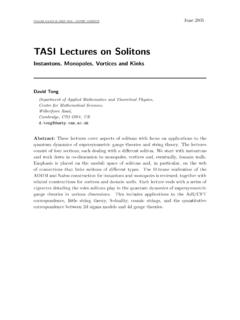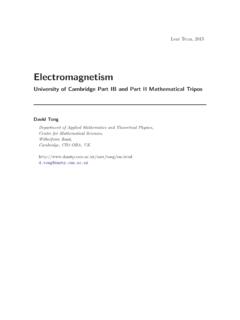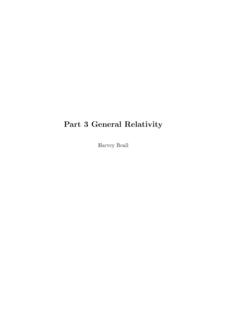Transcription of Quantum Field Theory - DAMTP
1 Preprint typeset in JHEP style - HYPER VERSION Michaelmas Term, 2006 and 2007. Quantum Field Theory University of Cambridge Part III Mathematical Tripos Dr David Tong Department of Applied Mathematics and Theoretical Physics, Centre for Mathematical Sciences, Wilberforce Road, Cambridge, CB3 OWA, UK. 1 . Recommended Books and Resources M. Peskin and D. Schroeder, An Introduction to Quantum Field Theory This is a very clear and comprehensive book, covering everything in this course at the right level. It will also cover everything in the Advanced Quantum Field Theory . course, much of the Standard Model course, and will serve you well if you go on to do research. To a large extent, our course will follow the first section of this book. There is a vast array of further Quantum Field Theory texts, many of them with redeeming features. Here I mention a few very different ones. S. Weinberg, The Quantum Theory of Fields, Vol 1. This is the first in a three volume series by one of the masters of Quantum Field Theory .
2 It takes a unique route to through the subject, focussing initially on particles rather than fields. The second volume covers material lectured in AQFT . L. Ryder, Quantum Field Theory This elementary text has a nice discussion of much of the material in this course. A. Zee, Quantum Field Theory in a Nutshell This is charming book, where emphasis is placed on physical understanding and the author isn't afraid to hide the ugly truth when necessary. It contains many gems. M Srednicki, Quantum Field Theory A very clear and well written introduction to the subject. Both this book and Zee's focus on the path integral approach, rather than canonical quantization that we develop in this course. There are also resources available on the web. Some particularly good ones are listed on the course webpage: Contents 0. Introduction 1. Units and Scales 4. 1. Classical Field Theory 7. The Dynamics of Fields 7. An Example: The Klein-Gordon Equation 8.
3 Another Example: First Order Lagrangians 9. A Final Example: Maxwell's Equations 10. Locality, Locality, Locality 10. Lorentz Invariance 11. Symmetries 13. Noether's Theorem 13. An Example: Translations and the Energy-Momentum Tensor 14. Another Example: Lorentz Transformations and Angular Mo- mentum 16. Internal Symmetries 18. The Hamiltonian Formalism 19. 2. Free Fields 21. Canonical Quantization 21. The Simple Harmonic Oscillator 22. The Free Scalar Field 23. The Vacuum 25. The Cosmological Constant 26. The Casimir Effect 27. Particles 29. relativistic Normalization 31. Complex Scalar Fields 33. The Heisenberg Picture 35. Causality 36. Propagators 38. The Feynman Propagator 38. Green's Functions 40. Non- relativistic Fields 41. Recovering Quantum Mechanics 43. 1 . 3. Interacting Fields 47. The Interaction Picture 50. Dyson's Formula 51. A First Look at Scattering 53. An Example: Meson Decay 55. Wick's Theorem 56. An Example: Recovering the Propagator 56.
4 Wick's Theorem 58. An Example: Nucleon Scattering 58. Feynman Diagrams 60. Feynman Rules 61. Examples of Scattering Amplitudes 62. Mandelstam Variables 66. The Yukawa Potential 67. 4 Theory 69. Connected Diagrams and Amputated Diagrams 70. What We Measure: Cross Sections and Decay Rates 71. Fermi's Golden Rule 71. Decay Rates 73. Cross Sections 74. Green's Functions 75. Connected Diagrams and Vacuum Bubbles 77. From Green's Functions to S-Matrices 79. 4. The Dirac Equation 81. The Spinor Representation 83. Spinors 85. Constructing an Action 87. The Dirac Equation 90. Chiral Spinors 91. The Weyl Equation 91. 5 93. Parity 94. Chiral Interactions 95. Majorana Fermions 96. Symmetries and Conserved Currents 98. Plane Wave Solutions 100. Some Examples 102. 2 . Helicity 103. Some Useful Formulae: Inner and Outer Products 103. 5. Quantizing the Dirac Field 106. A Glimpse at the Spin-Statistics Theorem 106. The Hamiltonian 107. Fermionic Quantization 109.
5 Fermi-Dirac Statistics 110. Dirac's Hole Interpretation 110. Propagators 112. The Feynman Propagator 114. Yukawa Theory 115. An Example: Putting Spin on Nucleon Scattering 115. Feynman Rules for Fermions 117. Examples 118. The Yukawa Potential Revisited 121. Pseudo-Scalar Coupling 122. 6. Quantum Electrodynamics 124. Maxwell's Equations 124. Gauge Symmetry 125. The Quantization of the Electromagnetic Field 128. Coulomb Gauge 128. Lorentz Gauge 131. Coupling to Matter 136. Coupling to Fermions 136. Coupling to Scalars 138. QED 139. Naive Feynman Rules 141. Feynman Rules 143. Charged Scalars 144. Scattering in QED 144. The Coulomb Potential 147. Afterword 149. 3 . Acknowledgements These lecture notes are far from original. My primary contribution has been to borrow, steal and assimilate the best discussions and explanations I could find from the vast literature on the subject. I inherited the course from Nick Manton, whose notes form the backbone of the lectures.
6 I have also relied heavily on the sources listed at the beginning, most notably the book by Peskin and Schroeder. In several places, for example the discussion of scalar Yukawa Theory , I followed the lectures of Sidney Coleman, using the notes written by Brian Hill and a beautiful abridged version of these notes due to Michael Luke. My thanks to the many who helped in various ways during the preparation of this course, including Joe Conlon, Nick Dorey, Marie Ericsson, Eyo Ita, Ian Drummond, Jerome Gauntlett, Matt Headrick, Ron Horgan, Nick Manton, Hugh Osborn and Jenni Smillie. My thanks also to the students for their sharp questions and sharp eyes in spotting typos. I am supported by the Royal Society. 4 . 0. Introduction There are no real one-particle systems in nature, not even few-particle systems. The existence of virtual pairs and of pair fluctuations shows that the days of fixed particle numbers are over.. Viki Weisskopf The concept of wave-particle duality tells us that the properties of electrons and photons are fundamentally very similar.
7 Despite obvious differences in their mass and charge, under the right circumstances both suffer wave-like diffraction and both can pack a particle-like punch. Yet the appearance of these objects in classical physics is very different. Electrons and other matter particles are postulated to be elementary constituents of Nature. In contrast, light is a derived concept: it arises as a ripple of the electromagnetic Field . If photons and particles are truely to be placed on equal footing, how should we reconcile this difference in the Quantum world? Should we view the particle as fundamental, with the electromagnetic Field arising only in some classical limit from a collection of Quantum photons? Or should we instead view the Field as fundamental, with the photon appearing only when we correctly treat the Field in a manner consistent with Quantum Theory ? And, if this latter view is correct, should we also introduce an electron Field , whose ripples give rise to particles with mass and charge?
8 But why then didn't Faraday, Maxwell and other classical physicists find it useful to introduce the concept of matter fields, analogous to the electromagnetic Field ? The purpose of this course is to answer these questions. We shall see that the second viewpoint above is the most useful: the Field is primary and particles are derived concepts, appearing only after quantization. We will show how photons arise from the quantization of the electromagnetic Field and how massive, charged particles such as electrons arise from the quantization of matter fields. We will learn that in order to describe the fundamental laws of Nature, we must not only introduce electron fields, but also quark fields, neutrino fields, gluon fields, W and Z-boson fields, Higgs fields and a whole slew of others. There is a Field associated to each type of fundamental particle that appears in Nature. Why Quantum Field Theory ? In classical physics, the primary reason for introducing the concept of the Field is to construct laws of Nature that are local.
9 The old laws of Coulomb and Newton involve action at a distance . This means that the force felt by an electron (or planet) changes 1 . immediately if a distant proton (or star) moves. This situation is philosophically un- satisfactory. More importantly, it is also experimentally wrong. The Field theories of Maxwell and Einstein remedy the situation, with all interactions mediated in a local fashion by the Field . The requirement of locality remains a strong motivation for studying Field theories in the Quantum world. However, there are further reasons for treating the Quantum Field as fundamental1 . Here I'll give two answers to the question: Why Quantum Field Theory ? Answer 1: Because the combination of Quantum mechanics and special relativity implies that particle number is not conserved. Particles are not indestructible objects, made at the beginning of the universe and here for good. They can be created and destroyed.
10 They are, in fact, mostly ephemeral and fleeting. This experimentally verified fact was first predicted by Dirac who understood how relativity implies the necessity of anti-particles. An extreme demonstra- tion of particle creation is shown in the picture, which comes from the relativistic heavy Ion Collider (RHIC) at Brookhaven, Long Island. This machine crashes gold nu- clei together, each containing 197 nucleons. The resulting Figure 1: explosion contains up to 10,000 particles, captured here in all their beauty by the STAR detector. We will review Dirac's argument for anti-particles later in this course, together with the better understanding that we get from viewing particles in the framework of quan- tum Field Theory . For now, we'll quickly sketch the circumstances in which we expect the number of particles to change. Consider a particle of mass m trapped in a box of size L. Heisenberg tells us that the uncertainty in the momentum is p ~/L.
